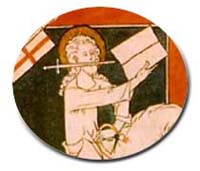 |
Forgotten Truths
The Holy Family Belonged to a Royal House
With the Catholic atmosphere infected with the viruses of Progressivism and Communism, St. Joseph is almost exclusively presented nowadays as an everyday workman, and the Holy Family as a proletarian family. Nothing is further from the truth. St. Joseph was a Prince of royal blood and a Patriarch.
We find it useful to offer our readers a commentary by St. Bernardine of Siena that certainly helps to cleanse our souls of these venomous viruses and focus the devotion of St. Joseph and the Holy Family in a true Catholic perspective.
St. Bernardine of Siena
St. Joseph accomplished the mission of being the guardian and provider for Mary and Jesus most faithfully, and for this reason the Lord addressed him with those words: ‘Well done, good and faithful servant, enter thou into the joy of thy Lord.’ These words reveal in the great Saint a threefold state.
The first describes in this holy man the state of nature, in which shines the nobility of his birth. The Lord said ‘good servant’ in reference to the noble nature that He conferred on him. In truth, he was from a patriarchal, royal and princely race. To better understand this, let us consider the natural nobility of the three members of the Family: Wife, Husband and Child.
The Blessed Virgin was nobler than any creature who had ever existed or ever will exist. St. Matthew, thrice listing the 14 generations from Abraham to Christ, shows that she descends from the 14 Patriarchs, 14 Kings and 14 Princes. St. Luke, also describing her nobility, goes back in his genealogy from Adam and Eve until the birth of Christ God.
Christ, who has not mother in Heaven nor father on earth, received from the Virgin all His humanity, and consequently the ancestry that makes Him a son of David and gives Him brothers of noble origin. His Most Holy Mother gave Him this. The dignity of Prince, King and Patriarch of the whole Israeli people was established in view of the Most Holy Virgin, to clearly demonstrate that the corporal nobility given to the human genre in Adam was given by God principally to reach, through numerous generations, the Virgin Mary; and through her, to end in Christ, the Most Holy Son of God.
St. Joseph was born of a patriarchal, royal and princely race in a direct line. St. Matthew establishes the direct line of all the fathers from Abraham to the spouse of the Virgin, clearly demonstrating that all patriarchal, royal and princely dignity came together in him.
Instead of giving the genealogy of Mary, St. Matthew described that of St. Joseph, which seems to have only an accidental relation to that of Christ, for three reasons:
First, to follow the custom of the Hebrews and of Holy Scriptures, which never establishes the genealogy through women or mothers, but always through men or fathers.
Second and principally, because of the kinship, Mary and Joseph belonged to the same tribe, and were relatives.
Third, he gave the genealogy of Joseph and not of Mary to show the excellence of their marriage, during which Christ was born, and wherein their union was so close that Joseph merited being called, and in a certain way he truly was, the father of Jesus Christ.
Christ was, therefore, a Patriarch, King and Prince for He received from His mother, from whom he received his substance, everything that other men receive from their mothers. For this reason, the Apostle says that He was born of Mary from the seed of David according to the flesh (Rom 1: 3).
St. Luke also describes the nobility of Christ … This nobility was prophesized by the Patriarch Jacob when he said: ‘The sons of thy father shall bow down to thee,’ referring to the adoration of the Divinity. And he added: ‘The scepter shall not be taken away from Judah' (Gen 49:8).
Thus the Evangelists described the nobility of the Virgin and of Joseph to manifest the nobility of Christ. Joseph was, therefore, so noble that, so to speak, he gave temporal nobility to God in the person of Christ Jesus.
(St. Bernardine of Siena, Saint Joseph,
Sao Paulo: Paulinas, 1956, pp. 17-23)

Posted August 25, 2007


Related Topics of Interest
 The Silence of Scriptures Regarding St. Joseph The Silence of Scriptures Regarding St. Joseph
 The Importance of Devotion to St. Joseph The Importance of Devotion to St. Joseph
 With St. Joseph at the Nativity With St. Joseph at the Nativity
 Don't Watch this Protestant Nativity Don't Watch this Protestant Nativity
 Prayer to St. Joseph for Families Prayer to St. Joseph for Families
 Our Obligation To Fight against Progressivism Our Obligation To Fight against Progressivism
 Catholic Intransigence Is Tantamount to Catholic Charity Catholic Intransigence Is Tantamount to Catholic Charity

|
Forgotten Truths | Religious | Home | Books | CDs | Search | Contact Us | Donate

© 2002-
Tradition in Action, Inc. All Rights Reserved
|
 |
|